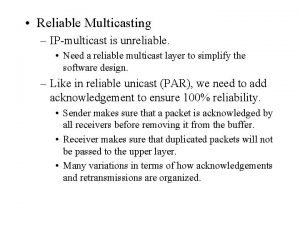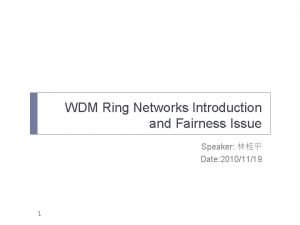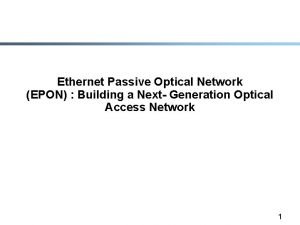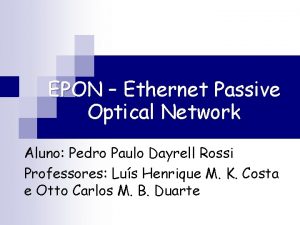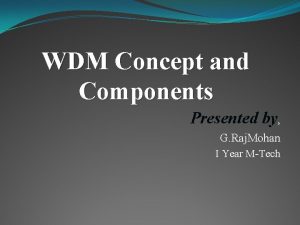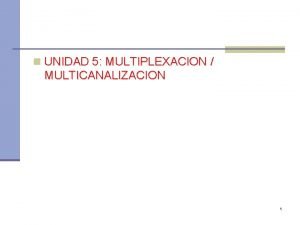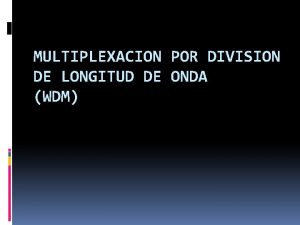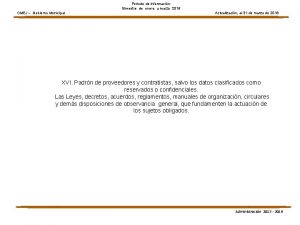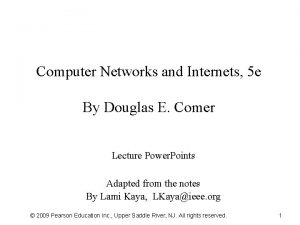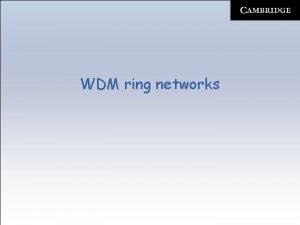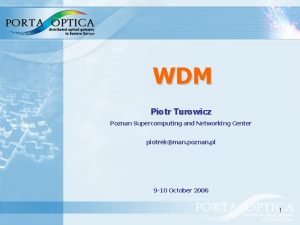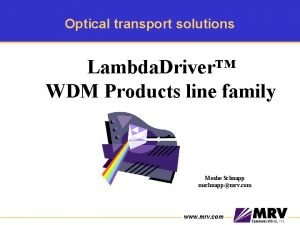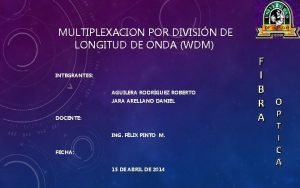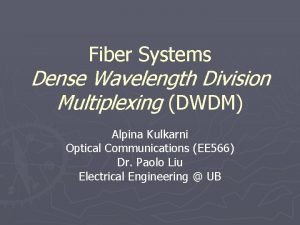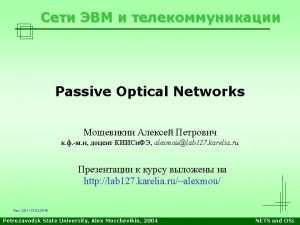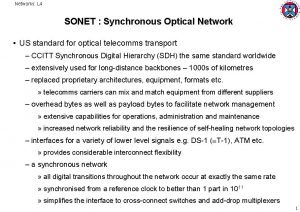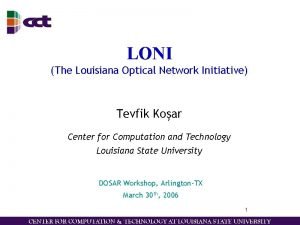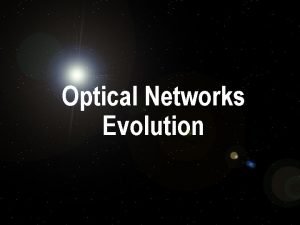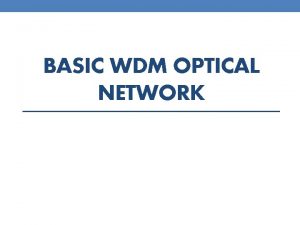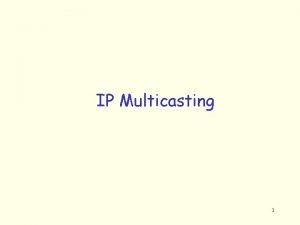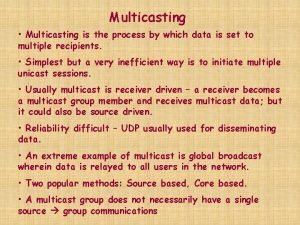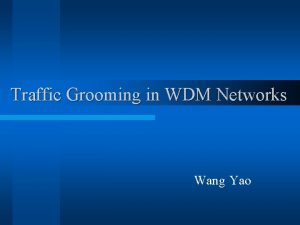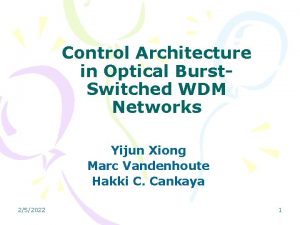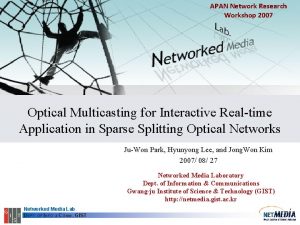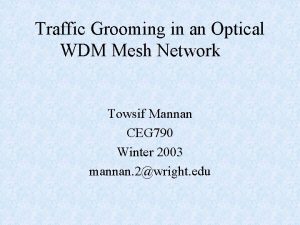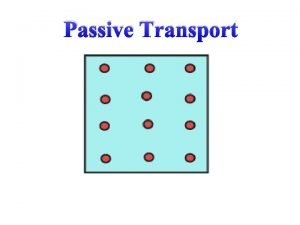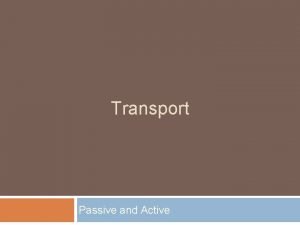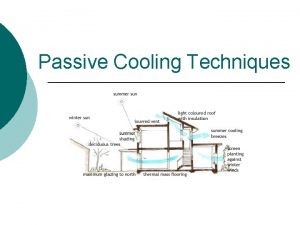A WDM Passive Optical Network Architecture for Multicasting





























![Simulation Results (Multicast) n Comparison with different Mean multicast size E[S] 30 Simulation Results (Multicast) n Comparison with different Mean multicast size E[S] 30](https://slidetodoc.com/presentation_image_h2/d102ce7c84639cca6e9491c6977d041e/image-30.jpg)








- Slides: 38

能支援群播服務之分波多 被動式光 纖網路的架構 A WDM Passive Optical Network Architecture for Multicasting Services 研 究 生:林澤賢 指導教授:吳和庭 博士 1

Outline n n n n Motivations Backgrounds A novel WDM Passive Optical Network Architecture The Proposed Multicast Algorithm Simulation results Scalability problem Conclusions Future works 2

Motivations n Network Environments ¡ ¡ n Downstream ¡ ¡ n Combined PSC and AWG WDM Passive Optical Network Multicast Transmission Unicast Transmission To Design a Multicast Scheduling Algorithm ¡ ¡ Simple Efficient 3

Backgrounds n Optical Devices ¡ ¡ n PSC AWG Passive Optical Networks ¡ ¡ ¡ TDM PON WDM PON SUCCESS-DWA PON 4

Optical Device-PSC n n The Passive Star Couple is a passive multiport device Wavelengths launched onto any input port are broadcast to every output port 5

Optical Device-PSC n The PSC is the preferred device to singlehop WDM networks ¡ ¡ n Advantages ¡ ¡ n broadcast-and-select single-hop WDM network TDM PON Broadcast signal Low cost Disadvantages ¡ ¡ Power loss Do not wavelength spatial reused 6

Optical Device-AWG n n n The AWG is passive wavelength routing device The same wavelength into any input port are routed to different output port This period of the wavelength response is called free spectral range (FSR) 7

The application of AWG device 8

Optical Device-AWG n Advantages ¡ ¡ ¡ n Static wavelength routing Wavelength spatial reused No power loss Disadvantages ¡ No broadcast channel 9

Passive Optical Network n In a PON, all components between the end users and the central office (CO) are passive, such as optical fibers and couplers ¡ ¡ ¡ TDM PON WDM PON SUCCESS-DWA PON 10

The TDM PON n n In a Time-Division-Multiplexing PON, end users share the bandwidth in time domain In the CO, an optical line terminal (OLT) transmits the downstream traffic to optical network unit (ONU) and manages the upstream traffic flows from the ONUs 11

The TDM PON 12

The WDM PON n What’s is Wavelength-Division-Multiplexing ¡ n n At the same time, a single fiber can carry Independent data streams on different wavelengths WDM PONs create point-to-point links between the CO and end user, no shared wavelength Advantages ¡ ¡ High Capacity Scalable 13

SUCCESS-DWA PON Architecture 14

Functional diagrams of the OLT and ONU 15

Proposed WDM Passive Optical Network Architecture n n Downstream – Splitter Upstream – Combiner 16

Downstream mode n n OLT use four tunable lasers to transmit control message on control channel or data packet on any wavelength Each ONU consists of a tunable receiver which allow them to receive control message on a control channel (or data on any wavelength) The multicast packet is received by the ONUs attached to the corresponding splitter Each splitter equally distributes all incoming wavelengths to all attached receivers. 17

Downstream mode 18

TL Timing Structure n n n Each TL transmits control message which corresponded to the ONUs of the same AWG output port in the control time Each TL transmits data packet to reach all ONUs attached to the same AWG output port in the data time A control packet consists of three fields, destination address, wavelength, and offset time 19

TL Timing Structure 20

Functional Diagrams of the OLT and ONU - Downstream mode 21

Functional Diagrams of the OLT and ONU - Downstream mode n Dispatch Mechanism ¡ ¡ ¡ n Sequential Random Short Queue First The Criteria for whether to Partition Multicast Packets depend on ¡ ¡ Multiple AWG Outputs ? Receiver Collision ? 22

The Proposed Multicast Algorithm n An All-Out Packet Is Defined to Be a Queued HOL Packet with All of Its Intended Recipients Free and at the same AWG output port in the Scheduling Time 23

The scenario of multicast algorithm n The HOL packet of Queue 1 is all-out packet 24

Simulation Parameters (Unicast) n n n n n The parameters are N = 64 ONUs The Tunable laser TLs = 4 Packet generation follows the Poisson arrival process Mean arrival rate = 0. 48~4. 32 packets/slot Bandwidth = 1 Gbps Packet Size = 1518 bytes Time slot = 12 us The Simulation during 1000000 slot time TDM Four-TDM-PON DWA SUCCESS-DWA PON 25

Unicast – Average Packet Delay n Average packet delay defined as the average time from the generation of a packet until the completion of the multicast transmission 26

Simulation Parameters (Multicast) n n n n Packet generation follows the Poisson arrival process Mean arrival rate = 0. 12~2. 28 packets/slot Bandwidth = 1 Gbps The time slot = 12 us Packet size = 1518 bytes The destination nodes of a multicast packet are randomly selected among all ONU Mean multicast throughput is defined to be the mean number of All-Out packets in the average time slot 27

Simulation Parameters 系統參數 說明 代表符號 Number of TLs OLT之可調式發射器個數 TL Number of ONUs ONU之個數 ONU Mean Multicast Size 平均群播封包的大小 E[S] D x D AWG的輸入與輸出端的個 數 AWG 網路架構 說明 DWA SUCCESS-DWA PON Short Queue First of WDM PON 28

Simulation Results (Multicast) n Comparison with different PON 29
![Simulation Results Multicast n Comparison with different Mean multicast size ES 30 Simulation Results (Multicast) n Comparison with different Mean multicast size E[S] 30](https://slidetodoc.com/presentation_image_h2/d102ce7c84639cca6e9491c6977d041e/image-30.jpg)
Simulation Results (Multicast) n Comparison with different Mean multicast size E[S] 30

Scalability Problem n n n Expanding ONUs Expanding TLs of the OLT Comparisons with different AWG ports ¡ ¡ 4 x 4 AWG port 8 x 8 AWG port 31

Expanding ONU 32

Expand TL of the OLT (1/2) 33

Expand TL of the OLT (2/2) 34

Simulation results 35

Conclusions n n n Proposed The Multicast Scheduling Mechanism for WDM Passive Optical Network Compare our proposed WDM PON with SUCCESS-DWA PON Scalability problem Study ¡ ¡ ONU FSR 36

Future works n n n Keep solving the scalability problem The upstream issue Compare with the AWG based Single. Hop WDM network and our proposed WDM network architecture 37

THE END 38
 Reliable multicasting
Reliable multicasting Internet multicasting
Internet multicasting Wdm network
Wdm network Wdm network
Wdm network Gigabit ethernet passive optical network
Gigabit ethernet passive optical network Gigabit ethernet passive optical network
Gigabit ethernet passive optical network Wdm concept
Wdm concept Wdm concept
Wdm concept Aircraft schematic manual (asm)
Aircraft schematic manual (asm) Multicanalizacion
Multicanalizacion Multiplexación por división de longitud de onda (wdm)
Multiplexación por división de longitud de onda (wdm) Wdm 990126350
Wdm 990126350 Fdm tdm wdm in computer networks
Fdm tdm wdm in computer networks Wdm ring
Wdm ring Wdm
Wdm Lambda driver
Lambda driver Wdm
Wdm Wdf_interrupt_config_init
Wdf_interrupt_config_init Fiber optic wdm
Fiber optic wdm Passive optical networks
Passive optical networks Doric vs ionic
Doric vs ionic Sonet synchronous optical network
Sonet synchronous optical network Loni pop
Loni pop Optical network evolution
Optical network evolution Optical mesh network
Optical mesh network Fspos vägledning för kontinuitetshantering
Fspos vägledning för kontinuitetshantering Typiska drag för en novell
Typiska drag för en novell Nationell inriktning för artificiell intelligens
Nationell inriktning för artificiell intelligens Vad står k.r.å.k.a.n för
Vad står k.r.å.k.a.n för Shingelfrisyren
Shingelfrisyren En lathund för arbete med kontinuitetshantering
En lathund för arbete med kontinuitetshantering Kassaregister ideell förening
Kassaregister ideell förening Personlig tidbok
Personlig tidbok Anatomi organ reproduksi
Anatomi organ reproduksi Vad är densitet
Vad är densitet Datorkunskap för nybörjare
Datorkunskap för nybörjare Tack för att ni lyssnade bild
Tack för att ni lyssnade bild Debattartikel mall
Debattartikel mall Magnetsjukhus
Magnetsjukhus
